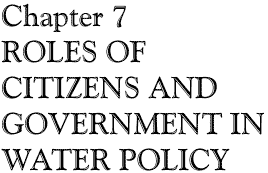
| ch. 7, pp. 96 - 97 |
In general, federal environmental laws do not apply to tribal lands. Most tribes have their own environmental and/or wildlife agencies, with regulations often modeled on federal laws. Since tribes control some headwaters of Arizona rivers, actions on tribal lands may significantly affect nontribal areas. Conversely, actions on nontribal lands have affected Indian lands. In some cases, nontribal entities such as mines have been allowed to use tribal lands with fewer environmental restrictions than would apply on nontribal land. Tribes and the U.S. Bureau of Indian Affairs have become more cautious in recent years about agreements that might result in polluted, waters and have more vigorously enforced their laws. The settlement of Indian water rights is an issue with broad implications throughout Arizona, not only to the tribes involved but also to non-Indians. Throughout much of U.S. history, Indians, their water rights systematically ignored and violated, have been an aggrieved party. The basis for Indian water rights claims is a U.S. Supreme Court decision (the Winters Decision), which established the principle that when the federal government set aside lands for Indian reservations or to serve other federal purposes, the government also implicitly reserved sufficient water rights to accomplish the purposes for which the reservations were created. These unrecorded and unquantified Indian water rights therefore were established at the time reservations were created, and so generally predate Anglo, non-Indian water rights. Although the Winters Decision was decided in 1908, only recently have Indian water rights gained serious recognition in the courts. Settling Indian water rights is very important to Arizona. With 21 Indian tribes controlling about 28 percent of the state’s land base, tribal water claims are extensive. Some observers argue that total tribal water rights in the state could exceed Arizona’s total surface water supplies. With no new sources of water available to allocate to tribes, water to settle Indian claims could come from present water users. The senior priority dates of Indian water rights means such rights have precedent over later water claims, usually belonging to non-Indians. Some CAP water, however, is presently unallocated and is available for use in Indian water rights settlements. The state of Arizona presently is involved in adjudications of the Gila River and Little Colorado River watersheds to determine the types, amounts, and priority dates of the rights of all water users in the watersheds. First initiated in 1978, the two Arizona adjudications will eventually determine the water rights of most water users in the state, including Indian tribes and the federal government. Seven tribes have filed claims in the Gila watershed, the principal watershed in Arizona incorporating the state’s largest population centers, Tucson and Phoenix. The Gila River adjudication is estimated to be the largest lawsuit ever filed in the United States, affecting 60,000 parties, including many in Pima County. Tohono O’odham Water Rights Although representatives of state, federal and tribal governments usually negotiate Indian water rights, implications of settlements can greatly affect cities and counties. For example, an understanding of the Tohono O’odham (Papago) water claims is essential when considering Tucson’s water future. Tucson’s early growth and development depended upon groundwater found in the Upper Santa Cruz Basin. This aquifer extends beneath the San Xavier District of the Tohono O’odham. As early as 1881, the Tucson Water Company drilled wells east of San Xavier to obtain water. This wellfield developed with the growth of the city, and by the 1970s Tucson pumped approximately 40,000 acre-feet of water annually from wells located just outside the reservation. Having by law to rely on an unresponsive federal government to promote and protect its interests, the tribe was left at a distinct disadvantage. By 1976, after several court cases that supported and defined Indian water rights, the Tohono O’odham were in a position to claim most of the available water in the Tucson Basin. The implications to non-Indian interests of such a claim were vast, with the possibility that bond ratings would be jeopardized, private loans more difficult to obtain, economic growth halted, and water possibly reallocated from current users to the Tohono O’odham. In 1975, the federal government, on behalf of the Tohono O’odham, sued the City of Tucson, mining companies and agricultural interests. In brief, the suit claimed the defendants damaged the tribe’s water rights by excessive pumping. The tribe had at least two strategies to follow: negotiate a settlement or precede with the suit to its final resolution. In the face of the cost, time and various uncertainties associated with a court case, a consensus developed that a negotiated settlement would be in the best interest of all involved. Tucson took the suit very seriously as is indicated by an excerpt from an Arizona Daily Star editorial at the time: “More than a century of government failure to preserve the Papagos’ interests assured the tribe a court victory. And victory for the Papagos could have meant the permanent shutdown of mines and farms and an end to city growth and development.” Such dire consequences, however, were unlikely, even with the Indians winning a court case. Negotiations took place with the express goal “to develop a fair and reasonable water resources plan which will satisfy the present and future water needs of eastern Pima County,” including “a speedy resolution of Papago Indian water right claims.” In making the best of a threatening situation, non-Indians used the suit as part of a strategy to benefit their own interests. By claiming that Colorado River water would be needed to negotiate with the Tohono O’odham, non-Indians were building a case for the federal government to complete the CAP canal to Tucson. Whatever settlement was negotiated would need to be financed by federal legislative appropriation.
|
